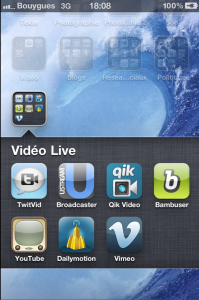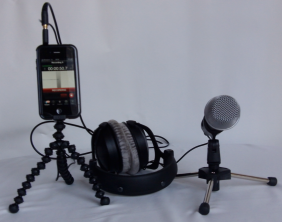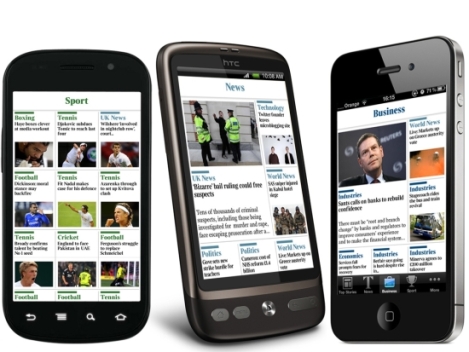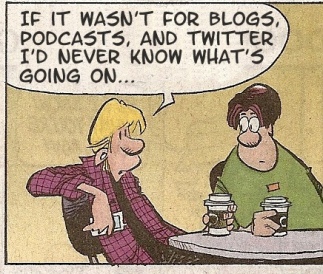Posts Tagged mobile
Smartphones: a new challenge for journalism
Posted by martaduarte in Technology on November 24, 2012
Radio, television, Internet and now smartphones, journalism is constantly faced with new technological revolutions. In the past decade, mobile phones became an essential part of our lives. Smartphones are practical and personal, their touchscreans look like paper and nowadays, a large part of the population owns one. All day long in our pocket, they allow us to access to any information at any time. With this new generation of mobiles, news is faster than ever and always accessible. You might even read this post on your smartphone.
Information on mobile is a revolution equivalent to what Gutenberg did.
Benoît Raphaël, chief editor of the Post
A new way for consumers to get news
In the United States, half of the population use mobile internet through a smartphone (44% against 35% in 2011) or on tablets (22% against 11% in 2011). Considering that 62% of owners of smartphones use them to get news, it’s a massive increase that changes how information is now consume and financed.
Even at home, people still use their mobiles to get information.
This new technology became an huge challenge and opportunity for media to get new content and to distribute it. Journalism must reinvent itself once more. People want to use their cellphones to get informations, then journalists have to evolve and provide an online and mobile version of their content. But smartphones are even more then that. Their use is not limited only to reading information, they can be used by journalists to find, treat and publish information too.
An other side of this technology that I’m going to talk about later, is the fact that it changes citizen journalism. Web 2.0 with his blogs and social networks have created citizen journalism and smartphones are speeding it up. In fact, it became a lot easier for citizen to publish information. Since you have a smartphone in your pocket, you can directly film, take photos and transmit them through the Internet.
How can journalists get and treat information with their Smartphones ?
 Our cellphones are not only phones anymore, they’re like a small computer that can be used for work. That’s why most journalists are now equipped with one. This way, they are always connected to the Internet and they can at any moment, search for latest news.
Our cellphones are not only phones anymore, they’re like a small computer that can be used for work. That’s why most journalists are now equipped with one. This way, they are always connected to the Internet and they can at any moment, search for latest news.
But above, smartphones can be used as tools. They are recorders and cameras, that can replace proper material for some occasions. Journalists should be multitasks and this devices make it easier. No need to be an expert in video or photography, applications on smartphones are within the reach of everyone.
In addition to the camera included on the phone – that are more performant every day – some applications exist that can be really useful for journalists. This is particularly the case for video editing apps, used by journalists to work on their reports, directly from their touchscreans. For the Iphone, different applications are available, like Splice and iMovie.
And once the video is edited, we can share it with Qik for exemple. A free application from the same editor as Skype, that can also be used to cover live events with its streaming function.
To learn more about those applications and others, and find links to download them, you can go here and here for even more details
There are plenty of mobile applications that are useful for journalists. The Knight Center of Journalism in the America’s blog of the University of Texas at Austin gives you a selection of five apps that every journalist should have.
We know that journalism is constantly changing and faced with new revolutions. And this mobile technology is one for the media.
It’s changing the way to work and the organisation of the redactions. With mobile devices, the journalism landscape is not the same anymore and for field journalists, smartphones have a prominent place in their work
Do we publish news on a phone application the same way as on a newspaper ?
Definitely not. People don’t read news on smartphones like on newspapers or even news sites. That is why medias have to create mobiles versions of their content that can be read with cellphones.
And how to do that ? Sentences and paragraphs should be shorter. Users can consult their news applications at any time but they don’t dedicate as much time as to newspapers. Moreover, it can be difficult to focus on a long text if it’s on a small screen. So journalists have to be able to reveal facts in a short way.
Headlines and subheads are important as well, they need to be really good worked to attract the attention of readers. This is true for newspapers too, but it became even more with the Internet, where information is overloaded.
We can also give a brief summary of the story, that users can read quickly on their phones. The idea here, is to bait people and to push them to read more about an information on an other support, that allow journalists to write a more detailed article, like newspapers or even websites.
An other important issue are videos and photos, they should illustrate the article and published along with the text, because it facilitates the reading. Likewise, they should be put on top of the topic to be easily accessible by mobile viewers.
Smartphones are giving a new life to citizen journalism
The distinct border between who consumes news and who produces it, is gradually becoming thinner. I’m not saying that journalism doesn’t exist anymore because anyone could do it, but that anyone can transmit information and facts. News consumers are often news producers as well. Imagine that you are witness of an unannounced protest or something like that, you’ll probably take photos and put them on the Internet. Thus, you can be considered as a news producer or a citizen journalist.
Online citizen journalism took his first steps with the transition to web 2.0 and with mobile devices, it became easier then ever. Smartphones allow you to take photos, videos and directly post them through the net. It’s fast, easy and free. Moreover, it can usually be seen by a lot of people and even become viral.
Most of the time, people post this kind of news and their own reporting, from their cellphones directly to social networks, like Facebook and Twitter. These platforms are often used for these purposes because they’re so accessible with smartphones applications. No need for much writing, a few words and a photo are enough to transmit a news. Then, people post status updates, notes, photos and videos from events regularly and often before mainstream media.
Therefore, this kind of news can be really useful for journalists. That way a journalist can be everywhere. If he finds something interesting that has been posted by someone in Twitter, he can include it in his own publication. So it can be a new tool for journalists to find information.
Youtube videos: now on your mobile!
Posted by lethynguyen in Entertainment, Technology on December 12, 2011
Youtube is a website created in 2005 by three former Paypal employees. This site enables people to display all kinds of videos. This website changed in time: it enabled people to upload longer videos, and lately, it also enabled people to watch video is 3D. In 2007, Youtube mobile was launched. To use it, you need a mobile phone that plays streaming videos like most 3G phones do. As Youtube mobile is a data intensive application, it is strongly recommended to have an unlimited data plan. Otherwise, you will end up with a huge bill!
Youtube for Mobile 2007
“YouTube is really starting to broaden their reach by letting people get this content through means other than their main website”
In 2010, a brand new layout for Youtube mobile got out. With a more attractive design and way more functionalities, this new app is ready to seduce the customers.
Advertisment for Youtube mobile 2010:
Developed by Google Inc., this application is free and compatible with most of the smartphones. It was downloaded between 100,000,000 and 500,000,000 times in the last 30 days.
Youtube mobile 2010
Due to the incredible popularity of Youtube mobile, I decided to test it myself! Here are my pros and cons:
Pros:
- you can watch more videos than with the earlier version.
- you can post and read comments easily
- you can record and share your home made videos
Cons:
- you don’t have a clear view of your subscriptions
- There is no personal viewing history
- the screen is too small
Conclusion:
I don’t think this new app is really useful. Of course it can keep you occupied when you are waiting for the bus, but it is not really pleasant to watch videos on such a small display. Most of the new functionalities created for smartphones are legitimate (emails, facebook, twitter) because they allow people to keep connected with each other.
However, Youtube is used for entertainment and this main function has been very well integrated to the new app. As you can record short movies with your cellphone camera, youtube mobile enables you to share them instantly (as shown at the end of the following video).
Youtube for mobile user’s guide:
Further information about youtube and youtube mobile:
http://en.wikipedia.org/wiki/YouTube
http://www.youtube.com/mobile?hl=en
https://market.android.com/details?id=com.google.android.youtube&hl=en










